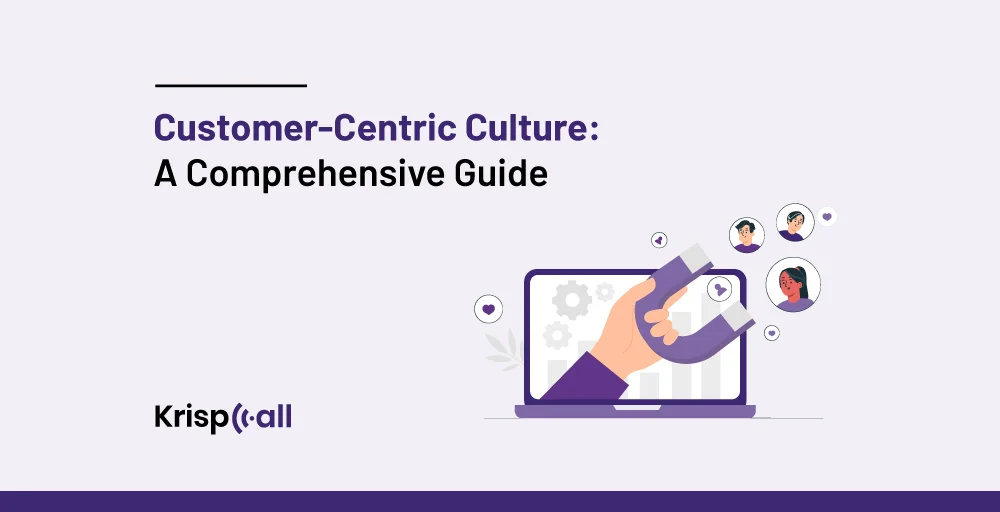Customers nowadays have high expectations regarding customer service. However, businesses fall short when it comes to meeting these expectations. Companies make customers wait for a long time on hold to interact with agents or make them feel like just another number in a sea of customers.
But the good news 😍here is that there’s a way for businesses to turn the table. It’s simple, its called being customer-centric. This simply means putting the customer first in each and everything you do, whether it’s through interactions, products, or services.
👉In this blog, you will learn about customer-centric culture, its importance, how you can build an effective customer culture, and some of the biggest challenges while building it.
🔑 KEY HIGHLIGHTS
- Customer centric culture is an organizational mindset and approach where everything revolves around meeting the needs and desires of customers.
- Prioritizing a customer-centric culture drives increased customer lifetime value, fosters brand ambassadors, empowers effective marketing strategies, and ultimately leads to enhanced revenue and long-term success.
- To foster a customer-centric culture, share vital customer insights across all teams. This empowers everyone to make informed decisions based on feedback and data, strengthening relationships..
- To cultivate a customer-centric culture, businesses must utilize tools for gathering and analyzing customer data, such as NPS scores and feedback.
- A significant challenge of a customer-centric culture is that employees may feel uneasy about adopting new work methods that prioritize customer preferences over their usual tasks.
What is customer-centric culture?
A customer-centric culture is an organization’s principle or set of commitments, strategies, and values that prioritize the customer at the heart of everything it does. It is all about delivering positive customer experiences through communications, products, or services.

Customer-centric culture is not only about providing satisfactory customer service instead, it’s about fostering an environment where every decision, action, and process is influenced by the goal of enhancing the customer experience.
Let’s understand it better with an example: Assume a retail store where staff is trained to proactively anticipate and meet customer needs. In this case, they don’t pressure customers to buy but offer tailored styling advice and recommendations.
Importance of Customer-Centric Culture
Creating a customer-centric culture is more than just providing what customers want, it’s about gaining trust of customers. A customer-driven cultures are important for businesses for a number of reasons, including:
Increased customer lifetime value (CLV)
Creating a customer-centric culture helps you boost the lifetime value of the customer. The customer’s lifetime value is nothing but a period in which the customer would continue to make purchases from your business.
Customers are likely to engage with businesses that listen to them, understand them, and deliver effective solutions. Moreover, creating a culture by focusing on customers allows you to build more value for them, which, in turn, helps businesses build a foundation of long-term engagement with customers.
Creation of brand ambassadors
There’s no second thought that loyal customers are somehow brand ambassadors of your businesses. When customers consistently have positive experiences, they feel valued and develop a sense of loyalty towards the brand.
And satisfied customers are more likely to become promoters for your brand, spreading positive word of mouth and attracting new customers without much effort. This will lead to increased sales, more customer loyalty, and, ultimately, greater profitability.
Loyalty
There is no doubt that providing a positive customer experience continuously is one of the most important factors in the business strategy to build customer loyalty. It creates a loyal customer base that continues to make purchases from your brand.
Moreover, it’s not enough to focus on a few touchpoints; instead, you must focus on the whole customer journey. To do this, start focusing on the customer relationship rather than just keeping an eye on the transactions.
Effective marketing
A customer-centric culture fosters a deep understanding of customer needs and preferences, which translates to powerful marketing strategies. By prioritizing customer insights, marketing teams can craft targeted messaging that resonates with specific customer segments.
In addition, a customer-centric culture equips marketing teams with the knowledge and tools to develop effective and targeted campaigns that resonate with customers, ultimately propelling business growth
Increased revenue
Focusing on customers’ problems and coming up with effective solutions definitely gives you good results and that is increased revenue and profit for your company. The more loyal customers continue to buy from your business for a long time, you can definitely expect that sales will continue to rise as long as you’re focused on delivering a customer-centric experience.
How to Build Customer Centric Culture?
Here are some significant ways to build a customer-centric culture in your organization:
1. Empower frontline employees
This is one of the crucial steps in fostering a customer-centric culture. You must know that your frontline employees are the first point of contact between business and customers. In simple terms, they are the face of your business.
Therefore, you should provide them necessary training that focuses on product knowledge, customer service skills, and problem-solving techniques.
Moreover, provide your employees with the necessary tools and resources. Make sure you equip them with up-to-date technology, proper access to customer data, and definitely a robust CRM system. This makes sure they have all the resources to deliver personalized and efficient customer service.
2. Democratize customer insights
To build a customer-centric culture, you must have crucial customer insights to build better relationships with them. Democratizing customer insights means making customer feedback and data accessible to all departments within an organization. This ensures that every team can make informed data-driven decisions.
Remember that for democratization to be effective, a culture of transparency must be created where all customer-related information flows freely. Moreover, creating a customer-centric culture includes regular discussion and evaluation of real-time customer experiences with both new and old employees.
3. Implement an eNPS & NPS scoring system
Implementing the Net Promoter Score (NPS) and Employee Net Promoter Score(eNPS) systems is an effective way to measure as well as improve both customer and employee satisfaction. 👉 Here’s how this scoring system helps businesses:
- Understanding customer and employee satisfaction: It’s common that continuously conducting NPS and eNPS surveys can definitely help businesses to determine how happy both customers and employees are with the businesses. In the end, this feedback can be efficiently used to identify areas for improvement to satisfy their needs.
- Prioritizing changes for improvement: Continuously analyzing the feedback and pointing out areas for improvement definitely provides you with a result which then businesses can use to determine what changes are most likely to improve employee and customer satisfaction. This will definitely empower agents to focus on delivering better customer experiences.
- Tracking progress over time: Both of these scoring systems (NPS and eNPS) can be used as indicators to track a business’s progress in creating a customer-centric culture over time. Similarly, continuously reviewing the scores and assessing the feedback helps businesses ensure they are significantly improving to meet the needs of their customers and employees.
4. Proactive customer support & customer support tools
Businesses that show proactive support to their customers definitely show they value them, which gives them good results in terms of customer satisfaction and loyalty. Proactive customer support is not only about anticipating customer needs, instead, it’s about addressing potential issues before they arise.
In addition, providing the right tools and resources to agents ensures they can quickly identify and solve emerging issues before they become headaches for them.This not only allows your employees to find quick solutions but also lets them solve issues instantly without the need for senior managers.
5. Tie compensation to customer feedback
Employees who are compensated based on customer feedback become more aware of their impact on customer satisfaction. They are also encouraged to improve their performance in ways that positively impact customer satisfaction.
Here are several important ways linking compensation to customer feedback can foster a customer-centric culture: 👇
- It ensures employee accountability, encouraging them to take ownership of their work and provide customer satisfaction above and beyond what is expected.
- It encourages employees to focus on customer inquiries more efficiently.
- Providing meaningful work, as well as a direct relationship between employee performance and customer satisfaction, increases employee commitment.
- It greatly enhances customer satisfaction, resulting in greater business success.
5. Delivering real-time customer experience training to staff
It’s a must to provide real-time training to your employees in order to maintain a customer-centric culture. This ensures that your employees are always equipped with the latest skills and knowledge set to effectively meet the customers’ needs.
Here’s how it helps in creating a customer-centric culture: 👇
- It gives managers a better understanding of the competencies, skills, and efficiency of employees who handle direct customer service.
- Give employees access to customer data and insights so they can learn, evaluate, and improve customer service strategies
- By using customer data, employees are able to adapt their actions and behavior instantly to meet the needs and expectations of their customers.
- This program encourages employees to take ownership of their actions and responsibility for the customer experience by holding them accountable for their performance.
6. Monitoring and evaluating performance at intervals
To enhance customer-centric culture, it is a must to monitor and evaluate key performance. All you need to do is set up KPIs to monitor customer-centricity across an organization. Here are major points on how you can monitor and evaluate performance at intervals:
- Identify clear performance metrics aligned with customer-centric goals. A few examples include net promoter score (NPS), customer satisfaction (CSAT) scores, first response time, and issue resolution time.
- Utilize both quantitative and qualitative data for a comprehensive view of performance. Quantitative data from surveys and CRM systems provides measurable insights, while qualitative feedback from customer interviews and support interactions offers a deeper understanding of customer sentiments and expectations.
- Implement regular performance reviews at both the individual and team levels. For employees, this could be monthly one-on-one meetings where performance data is reviewed and specific feedback is given. For teams, hold quarterly reviews where collective performance is assessed and strategies are developed to address any identified issues.
- Streamline the monitoring process with technology. As a result, managers can quickly identify trends and areas that require attention using dashboard tools that provide real-time updates on key performance indicators (KPIs).
7. Delivering a feeling of value
It’s universal that when customers feel valued and heard they are more loyal towards the brand. The only way to achieve this is by engaging with them honestly, with authenticity, and, of course, with respect. Also, it’s a must to remember that the feeling of being heard and valued must be from the customer’s side rather than the business perspective.
As you know, consistency is the key. So, deliver value by personalizing customer experiences. For instance, you can use customer data to personalize interactions and offerings to the individual’s needs and preferences. Moreover, personalized experiences make customers feel valued and understood, which in terms, fosters loyalty and long-term relationships.
Furthermore, active listening, thanking them, and offering proactive support and services are some of the effective ways to make your customers feel important. These methods show that companies care about customer’s preferences and needs, and they are continuously committed to providing exceptional customer experiences.
8. Implementing proper tools for data collection and analysis
To better understand customers, implementing proper tools and technologies for collecting and analyzing customer data is a must for creating a customer-centric culture. To do so, you can track and monitor crucial metrics like NPS scores, customer behavior, and feedback, from which businesses can gain deeper insights into customers’ tastes about products and services.
With these data in hand, businesses can make informed decisions about how they can optimize their specific products and services to effectively meet customers’ needs and preferences. Doing that shows how businesses are committed to listening to customers and prioritizing their needs.
9. Assigning and embedding proper roles and responsibilities to the staff
It’s often seen when employees’ skills and knowledge are not utilized to the maximum level. But identifying your employee’s skills and assigning them with proper roles and responsibilities reduces chaos and confusion.
For instance, when employees are aware of their roles and responsibilities, this leads to increased employee productivity, operational efficiency, and individual performance.
What are the biggest challenges companies face in implementing a customer-centric approach?
Here are some major challenges you might face in implementing a customer-centric approach:
Organizational silos
One of the primary challenges is the presence of internal barriers and departmental silos. These barriers can significantly hinder the free flow of customer insights and collaboration across businesses. Each department might focus on its own goals rather than the overall customer experience.
Resistance to change
Employees might get uncomfortable with new ways of working that focus more on customer’s preferences rather than their daily and usual tasks. This makes them feel unsure about trying new methods or worry about their job security.
Lacks data integration
To understand customers as a whole, businesses must look at all the data about their interactions and preferences. But the problem here is, this data is often stored in several places. This makes it hard to get a complete picture. So what businesses need to do is that they need to bring all this data together so that they can see and use all information about customers in one single place.
Short-term focus
It’s common for businesses to feel pressured to get quick results in a short period of time. But this leads them to focus on short-term gains instead of building long-term relationships with customers. Building a true customer-centric approach requires long-term thinking, which means investing in strategies that build lasting customer loyalty, doesn’t matter even if they don’t show quick results.
Final Words
Building a culture of customer-centric values definitely requires a focused strategy and, most crucially, the realization that it’s a must for business success. In simple terms, a customer-centric culture is no longer a luxury instead, it is a necessity for long-term business success.
Moreover, businesses that prioritize customer satisfaction, loyalty, and advocacy can establish effective and meaningful relationships that drive growth and profitability in the long run. Meanwhile, using innovative solutions like KrispCall can further enhance the customer experience, enabling seamless conversations and personalized interactions across various touchpoints.
Ready to transform your business with a customer-centric approach?
FAQ
What are customer-centric values?
A customer-centric approach prioritizes the needs, preferences, and satisfaction of the customer. Across the organization, these values guide decision-making and behavior to improve the customer experience.
What behaviors are customer-centric?
Actively listening to customer feedback, anticipating their needs, personalizing interactions, promptly resolving issues, and continuously improving the overall customer experience are all customer-centric behaviors
What is customer culture?
Customer culture is the mindset, values, and behaviors that an organization promotes to keep customers happy and loyal. Customer-centricity encompasses the attitudes and actions of all employees and the systems and processes that support it.
What is a customer-focus example?
An example of customer focus is a company that consistently goes above and beyond to meet the needs and preferences of its customers. The process may involve providing personalized recommendations, exceptional customer service, and seeking feedback to improve products and services.





